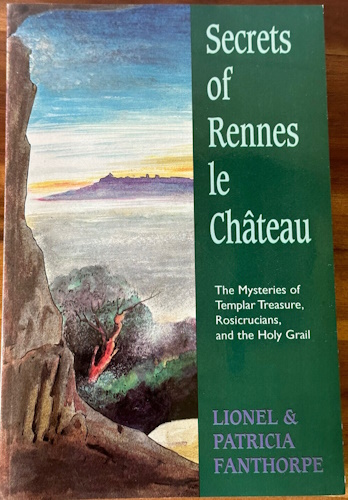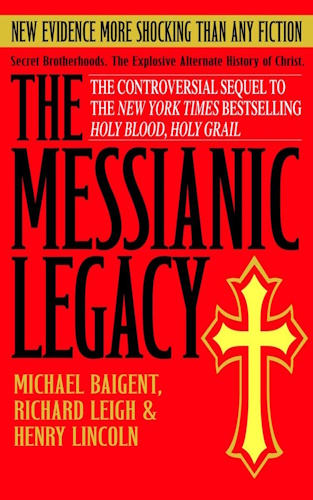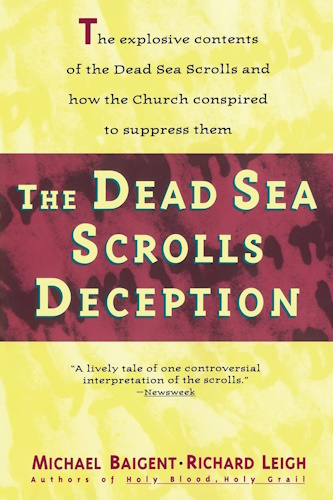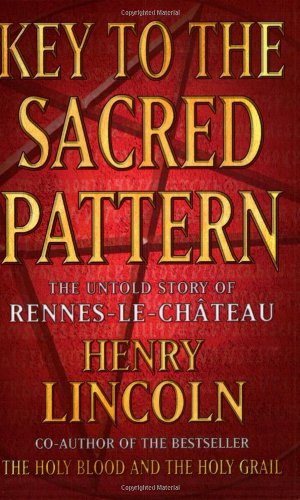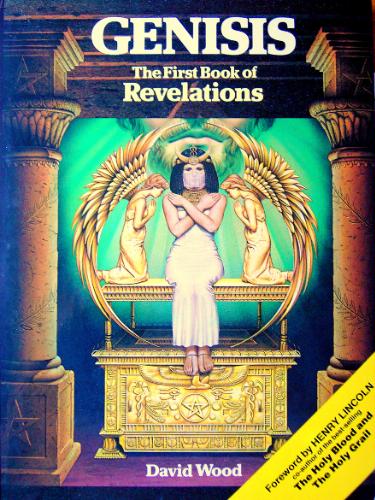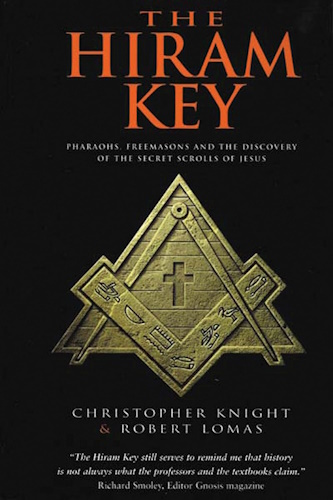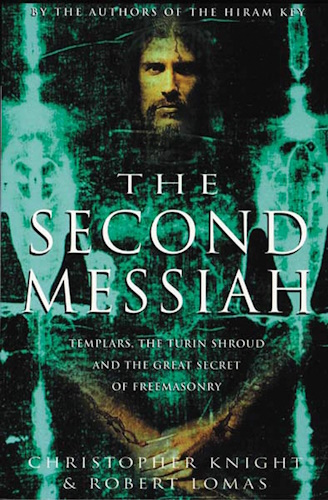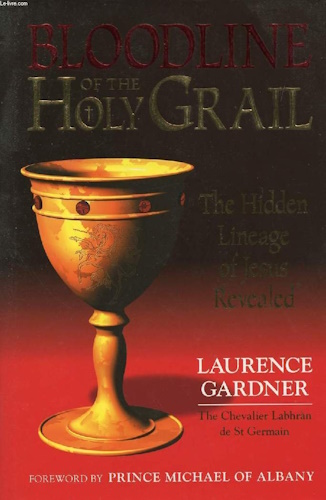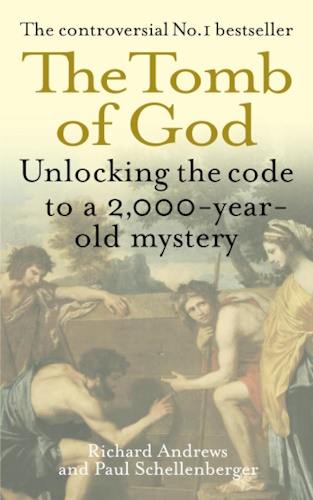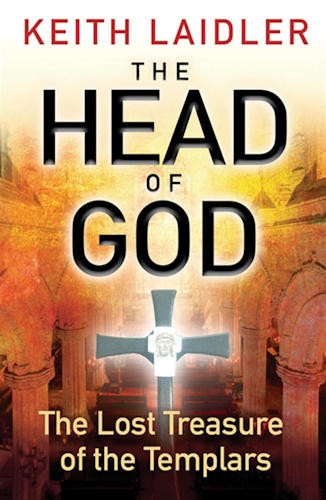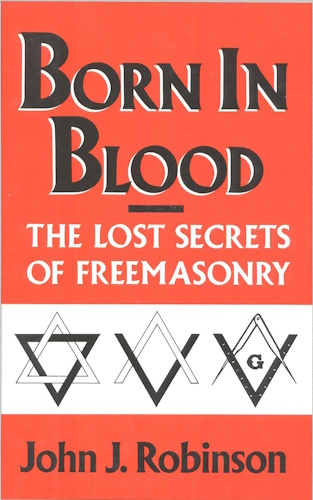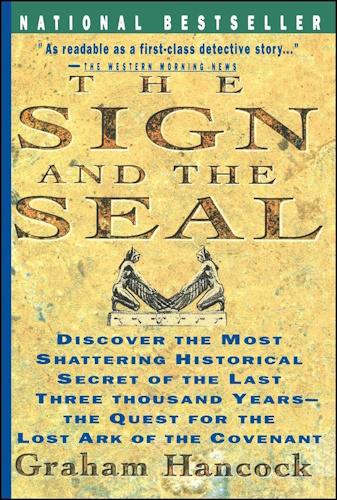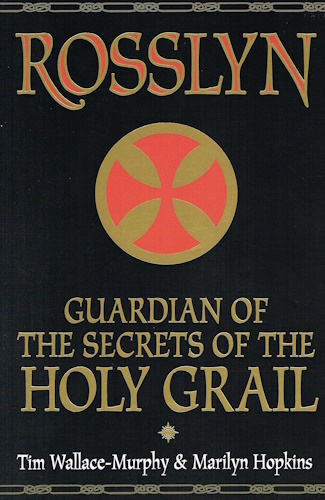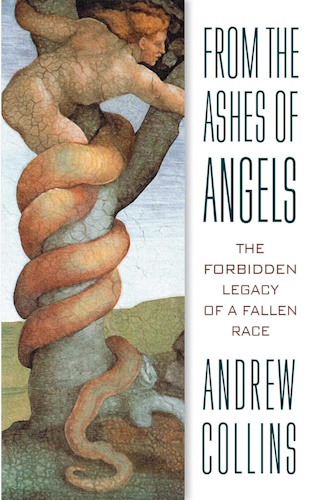![]()
Priory Of Sion:
The Facts, The Theories, The Mystery
by Steve Mizrach
![]()
Introduction
It has been seven years since I wrote my first article on the Priory of Sion/Rennes-les-Chateau mystery. At the time, I was heavily under the influence of the books Holy Blood, Holy Grail and Lionel Fanthorpe's work. Since then, there have been a number of books released, some better, some worse, than these original influences. I have revised some of my theories, challenged some of my own assumptions, learned some new things, and encountered a great deal of contrary data. Now, I am no longer sure that the hypothesis presented at the end of Holy Blood, Holy Grail is the best for explaining the data, nor am I sure that a Priory of Sion with the characteristics ascribed to it (an 800-year uninterrupted history, 9000 members internationally) really exists. I also am not sure that what is presented as "orthodox" with regard to the Sauniere saga can really be trusted. Still, although I have encountered the work of the debunkers, I am sure of two and only two things:
- the Sauniere saga cannot be explained away simply by a mass-trafficking pyramid scheme and a bad taste in décor.
- Something called the Order de Sion existed in the Middle Ages up until, at the latest, the 17th century; something called the Prieure du Sion existed from at least 1956 to 1984; whether these two things have any actual relationship to each other, I am still trying to figure out.
I believe that people get lost in certain obsessive details regarding this mystery, in particular details having to do with the life of Jesus, the idea of some type of mysterious bloodline with genes from (God/aliens/angels/Nephilim/Merovech/take your pick), lost artefacts (the Shroud of Turin, the Ark of the Covenant, the Holy Grail, the head of John the Baptist, etc.), or conspiracy theories (on the part of the Catholic Church, the French Geographic Institute/IGN, and various ludicrous New World Orders). In this essay, I'm going to attempt to present my current, "millennial" take on this mystery. I will actually attempt to argue beyond the mere basis of statements a and b, but I will attempt to present why I believe this is the case. Since this is not a scholarly essay, it will not be heavily referenced and footnoted, but I believe all assertions in here are defensible, and can present the sources on which I think they are based. Many ideas in here come from the three years of discussion I have had on the priory-of-sion egroups list, with a wide-ranging variety of erudite minds.
In lieu of writing a book on this subject, which I really at this time don't want to do, I think this essay is one of the better ways to communicate my current thoughts on this subject. I apologize for any errors in advance, but cannot claim infallibility, only a desire for accuracy. Should any of these things be proved false, I am fully willing to withdraw those statements. Unlike others writing on this subject, I have no agenda, no desire to manipulate or deceive, only to deal with the information and offer my theories and interpretations. I have decided the best way to present this data is chronologically.
Some would begin this story back in the hoary mists of prehistory, or in the time of Jesus, or with the coming of the Merovingian Franks to Gaul, or in ancient Sumeria. I prefer to start at one particular place.
1090 - 1188 The Ordre de Sion
According to the "prieure documents," a conclave of Calabrian monks who left from the Belgian Abbey of Orval in 1090 helped secure the election of Godfroi de Bouillion as de facto king of Jerusalem during the First Crusade (but as is well known, he refused the title, accepting only Defender of the Holy Sepulchre), based on their belief that he was a descendant of the Merovingians, and by that fact, according to these documents, also a descendant of King David through Jesus and Merovech. In return, Godfroi secured their installation into an Abbey on Mount Sion. These documents also claim that the Ordre of Sion and the Order of the Temple (officially, the Poor Knights of the Temple of Solomon, later known as the Knights Templar, and officially recognized as such in 1118) were, until 1188, one unified organization with the same leadership.
Is there any basis to these claims? Here is what it is apparently true: there was indeed an Order of Sion based on Mt. Sion, and according to a papal bull of the 12th century, it had monasteries and abbeys elsewhere in Palestine (in particular, Mount Carmel), in southern Italy (Calabria), and in France. There is little in the official histories linking Godfroi to this order, but he is said to have founded the Order of the Holy Sepulchre, whose relationships to these other orders (the Temple and Sion) are unclear. And the official histories do not indicate any overlap between these monks and the soldier-monks of the Knights Templar. The Order seems to have occupied its "mother" abbey, Notre Dame de Sion/St. Mary of Mt. Zion, built on the foundations of the original apostolic Cenacle or Coelaneum, up until around 1291 or so, when like many Crusader holdings, it was overwhelmed by the Moslem onslaught. It actually was in the hands of the Franciscans for several more centuries, until it finally was lost to Christian ownership and was converted to a mosque.
I have found interesting links between the Order de Sion and the Carmelites. St. Berthold, the founder of the Carmelites, also originated from Calabria. Fra Lippi, a tutor of Botticelli, who is listed as a PoS GM, lived in Calabria and was known as "The Carmelite". Crotone in Calabria was the home of the Pythagorean school, and Pythagoras is said by Iamblichus to have visited Mount Carmel. Calabria was the "stomping grounds" of Joachim of Fiore and Giordano Bruno. Most interestingly, recent archaeological articles suggest the Essenes had encampments on both Mount Carmel and Mount Zion. St. Therese of Liseux turns up in a number of "PoS churches", and she took her name both from Theresa of Avila, a Discalced Carmelite and mystic, and Therese of Lidoine, a Carmelite nun who was murdered by the Revolutionary Terror in Compeigne.
The Abbey of Orval's web site says only that mysterious monks from Calabria came there in 1070, although little is known about their identity, and they were welcomed there by Count Arnould de Chiny. These "pioneers" moved out after forty years, i.e. around 1110. The legend of Orval claims that it was named by Mathilda de Tuscany, who after finding a lost ring declared the place "a Valley of Gold" (Val D'Or.) That name will turn up again... recent research also suggests that Nostradamus may have found some "Templar" materials at the Abbey of Orval.
What I have found quite interesting about this Order is their choice of real estate. According to a recent (1990) issue of Biblical Archaeology magazine, Mt. Sion seems to have been the "HQ" of the Ebionites of Jerusalem - those "Judaizing" followers of Jesus who looked to his brother James, rather than the "Apostle" Paul, for leadership. Pauline Christians, in fact, avoided the place until the Byzantine period (7th century). It looks like some of these followers even made an abortive attempt to build a 3rd Temple of Solomon on the site after the Great Revolt of 70 CE, using the ruins of the destroyed Herodian templeÖ an effort that seems to have come to an end with the decisive defeat of the Messiah Bar Kochba in 135 CE. This choice does not appear arbitrary: the Old Testament says that Solomon's Temple sat on Mt. Zion, which although identified with Mt. Moriah for many centuries, by the 2nd Temple period was once again recognized as a mountain outside the existing Jerusalem city walls. I believe their choice of Mt. Sion for their Abbey displays an obvious "Ebionite" outlook on their part.
However, it seems like several monks had vacated from this Abbey prior to its emptying in 1291, and it does appear that quite a few went back to Orleans, France with King Louis in the 12th century. Others went to southern Italy (Calabria was the home of the heresies of Joachim of Fiore - a very unorthodox territory). The Order of Sion did not apparently cease to exist, though, even after losing its "mother" abbey in Jerusalem, and according to one perhaps less than totally reliable authority, Gerard de Sede, it continued on for quite some time, until being absorbed by the Jesuits in the 17th century. Prior to this dissolution, though, the "prieure documents" claim Sion and the Templars underwent a separation, at an event called the 'cutting of the elm' at Gisors in 1188. The "prieure documents" claim Sion's first independent "grand master", Jean de Gisors, was elected at this time: Sion and the Temple were no longer under the same leadership, and each went its own way.
This event, like so many others, appears to be based on some historical events, but perhaps shrouded with the clouds of myth. We know that there was indeed an ancient elm tree at the fortress of Gisors, often used as a neutral meeting point for the monarchs of England and France. And, indeed, there was a "parting of the ways" that occurred there, but it was not a division between Sion and the Templars. In January of 1188, the kings of England and France agreed to a truce at this elm tree, so that they could launch yet another common Crusade to the Holy Land. But in August, further meetings at the tree resulted in the collapse of this truce. One side became agitated over the fact that the other was hogging all the shade from the tree, the French and English skirmished, and finally it was cut down after a bloody battle. There is no evidence that Jean de Gisors was there or the Templars, but it seems hard to see why either would be uninvolved with a struggle that occurred in their physical and moral backyards.
Thomas a Beckett met with papal legates at the tree of Gisors, after his "excommunication" of some opponents (including a Hugh St. Clair) at Vezelay. Beckett appears to have been an important figure for Jean de Gisors, who dedicated several buildings to him. He was "martyred" on December 28th, the Feast of the Holy Innocents, for refusing to back down over his stance on the separation of sacerdotal and royal authority. Gisors also has a weird "parallel legend" to RlC: whereas RlC's daemon guardian must be defeated at noon (probably on the summer solstice), Gisor's "treasure" is guarded by a daemon who can only be passed at midnight on December 24th (the winter solstice).
1188 - 1307: The Rise and Fall of the Templars
Although the Order de Sion and the Knights Templar parted ways, at least according to the "prieure documents", in 1188, they still seem to have had some sort of interconnection, and some artefacts, knowledge, documents, etc. relating to the current 'mystery' seem to have remained in the Templars' possession. Thus, a great deal of investigation into the PoS/RlC mystery seems to revolve around the mysteries of the Templars. Did they possess some type of treasure? Were they heretics, dabbling in Ebionism, Johannism, or Essenism? Did they have some kind of "hands off" pact with the Cathars of southern France? Did they continue to survive in some kind of clandestine fashion after the order's "official" dissolution?
Again, here is what can be known. During their short but meteoric career, the Knights Templar became known for more than just their skill as soldiers or their piety. They became bankers, diplomats, and power-brokers. An elite few even became scholars, attempting to translate Hebrew Old Testament texts (such as the Book of Maccabees) into the vernacular. Charges of heresy and disloyalty dogged them for a long time, even as early as the early 12th century. Some of this undoubtedly arose from envy: as the bankers of Europe, the Temple acquired quite a formidable stash of gold. As it turns out, while northern Templars pursued the Albigensian Crusade with relish, gleefully slaughtering the Cathar heretics in the name of the Pope, southern Templars seem to have been more reluctant to take up arms against their neighbors. Scholars have argued whether this might have had to do with political loyalties (to the kingdom of Aragon) or family ties, but in any case, it does seem somewhat puzzling.
In 1307, on the rather inauspicious date of Friday, October 13th, King Philip the Fair ordered the arrest of the Templars on the charges of heresy. Historians conclude he was mostly after their wealth, having already seized the assets of the Jews in his realm a year earlier. Legal inquiries ensued, and Grand Master Jacques de Molay was thrown in prison. In 1312, during the Council of Vienne, the Pope (who was in Philip's "pocket"), dissolved the Templars as a religious order. Finally, in 1314, after refusing to renounce his claim of innocence, Jacques de Molay was burned at the stake in Paris as a relapsed heretic. Outside of France, Templars endured different levels of treatment - in some countries, they were hardly bothered at all, while in France they suffered torture, harassment, and vigorous persecution. Also, outside of France, the charges were more widely viewed with disbelief. The King and Pope did not outlast deMolay by long, dying several months after him.
As for their orthodoxy, the only real evidence that the Templars were anything less than pious, dumb, and loyal Catholic knights is their testimony at their trial. And, sadly, most of this testimony has to be ruled out, since most of it was obtained under torture. While under the hot irons of the inquisitors, the Templars admitted to intercourse with demons, worshipping black cat familiars, sodomy, and black magic, charges that no scholar takes seriously. In truth, these type of charges are a familiar litany that often turns up when a persecuted group was tortured by the inquisition - they show up during the witch-trials of two centuries later, and of trials of other Gnostic heretics centuries before. Thus, they probably reflect more of the demon-obsessed mind of the inquisitors than anything else.
Yet, there is a hidden "subtext" which suggests that, although many of the charges were trumped up in a Stalinesque (or Kafkaesque) kangaroo court (which we will return to later), heresy was already brewing among the Templars. For one thing, many Templars made a rather confusing confession. They claim they went through initiations by their superiors in which they were told to worship G-d the Father, but were also to spit on the cross and deny the Trinity. This is not the type of thing normally confessed to under torture by someone trying to tell their confessor what they wanted to hear, so the torture would end. After all, why not just say they had gone over to the Devil's side, rather than simply declaring that they had adopted a non-Trinitarian (perhaps "Ebionite"?) Christianity? Many people think the Templars incapable of heresy because they were unintellectual fighting men. However, the heresies of the Middle Ages often spread primarily among illiterate peasants.
A number of Templars outside of France, including some in England, were never tortured, yet made similar confessions. Indeed, many claim that the main heresiarch within the order was Roncelin de Fos, a 13th century Templar who was of Cathar ancestry. At some point, Roncelin began forming clandestine "cells" within the order, spreading his heretical teachings and initiations. Apparently, the leadership was unaware of this internal 'virus,' which may be why De Molay went to the grave honestly protesting his innocence - he truly had no knowledge of heresy within the order. There is also the possibility that some rather innocent deviations on the part of the Templars were simply misunderstood as "heresy" by their inquisitors and blown out of proportion. Whatever the case may be, charges suggesting the Templars were heretics went back to the 1140s - while, interestingly, their 'companion' order, the Knights Hospitaller of St. John, never faced similar chargesÖ but the only remotely heretical artefact the inquisitors ever found was a silver woman's head in a Templar perceptory marked "Caput LVIIIm".
If the Templars ever had a "treasure" other than a great stack of florins, history doesn't record it. Certainly, there are a number of Masonic ritual degrees (like the Holy Royal Arch) that suggest that they conducted some exploration on the Temple Mount, and either found some scrolls or the Ark of the Covenant itself. Other sources, like Ian Wilson, claim they had the "Mandylion" or Shroud of Turin prior to its display at Lirey in the 1350s. And, of course, there are always the persistent rumors that they held secret negotiations with the Hashisheen or Assassins led by the Old Man of the Mountain, Hassan-I-Sabah, or the Druzes of Lebanon, and from them obtained some esoteric materials. Although sources seem to disagree as to whether this treasure was spiritual, material, or documentary, this has not stopped people from looking for it, at Rosslyn Chapel, Gisors, Rennes-les-Chateau, Stenay, and elsewhere.
Equally in dispute has been the fate of the Templars after their 1312 dissolution. In many countries, they were simply folded into "new" military orders which consisted of the same people under a different name - for example, the Knights of Christ in Portugal. In England and in many countries, some went on to join their former friendly rivals, the Hospitallers. This may have been a good decision, considering the number of assets of the Templars turned over to their rivals. In France, most of the knights hung up their swords and retired to non-military monasteries, although a few went "rogue" and became mercenaries, pirates, or freebooters. However, there have always been the persistent rumors that the Templar order "survived" in some clandestine form after its own dissolution. For example, the Charter of Larmenius says that before de Molay died, he appointed a "clandestine" Grand Master to continue the order in defiance of the Pope's bull. Many of the "neo-Templar" orders of today claim they are the continuation of this 'survival', often with little or no proof. And, of course, there are those who say the Freemasons are the heirs of the Knights Templar.
Whatever the "PoS" is or was, it seems to have some interest in the Templar legacy, because in their documents they indicate some interest in Templar "materials" supposedly left behind at Gisors, where many Templars were imprisoned or detained. Assuming there is any validity to the "prieure documents" account, Sion and the Temple would have maintained some type of contact with each other, and the OdS would probably have some awareness of the disposition of their "sibling" order's people, property, and materiel.
1307 - 1600: The Reign of the White Queen
It ís not clear what exactly the OdS was up to in the 14th- 17th centuries, although the "prieure" documents suggest that during this time it had some fairly august leadership: Leonardo da Vinci, Nicholas Flamel, Rene D' Anjou, and Sandro Filipepi (better known as Botticelli). The alchemist Flamel translated the mysterious text of the Sacred Magic of Abra-Melin, whose original author was one "Abraham the Jew," through the assistance of some Spanish Rabbis. Upon his return from Spain, he is said to have achieved the "Great Work" of alchemy on the "PoS date" of January 17th. As for "Good King Rene," he seems to have been one of the figures promoting the mythic theme of Arcadia in Europe, a theme that seems an idee fixe for the "PoS". It is the appearance of daVinci on this roster - daVinci, the visionary, the artist, the man who wrote in backwards mirror writing, the inventor, the man who some say put his own face on the Shroud (although others claim it is de Molay's) - that has people most fascinated.
DaVinci seems to have had a "thing" for John the Baptist, which seems quite consonant with the apparent "PoS" interest in Johannism (the idea that John was the true Messiah and Jesus a false one, or, alternatively, that they were equal co-Messiahs). Johannites believe that there was a secret teaching passed from John the Baptist to John the Beloved Disciple (whose given name was Lazarus, but he took the "alias" of John to honor the Baptist), and to a "John" ever since. (Supposedly, every PoS GrandMaster takes the name "Jean" as an honorary title, in addition to being known as "Nautonnier" or Navigator.) Pincknett and Prince believe Da Vinci put his own face on the Shroud of Turin (despite accounts which suggest it was first shown at Lirey 200 years earlier), which was confirmed to them by someone they believed to be a member of the PoS, "Giovanni".
During this time period, the Duke Jean de Berry, who lived in Bourges, commissioned a picture-book known as Les Tres Riches Heures. A horological manuscript, illustrating the seasons of the calendar as well as miscellaneous episodes, the Heures has fascinated people with some of its strange symbolism. For example, it shows the Duke de Berry holding a caduceus or serpent-staff. The picture of the Resurrection also seems somewhat oddly dissonant with New Testament accounts, also. Certain scenes in the Heures also appear to be alluded to by the Rennes-les-Bains cleric Henri Boudet. The 20th century alchemist "Fulcanelli" had a lot to say about hidden symbolism in the Heures, and he in particular pointed to the role of Jacques Coeur of Bourges in its creation. Bourges is considered the esoteric "Coeur" of France.
Queen Blanche d'Evereaux, "The White Queen" of many prieure documents and listed as a PoS GM in those documents, had a chateau near Gisors at Neaufles. There was supposed to be a secret tunnel linking Gisors with her chateau. In the Prisoner's Tower at Gisors was imprisoned one Nicholas Poulain, an ambassador of the Douglasses of Scotland, allegedly for being Blanche's secret lover. Poulain supposedly scrawled a number of alchemical and hermetic diagrams on the walls of his jail. Poulain may have been connected to the "Freres-Aines de la Rose-Croix," a group of "survivor" Templar alchemists in Scotland. Blanche may have given some of his secrets to her "PoS successor," Nicholas Flamel, whose sigils and diagrams in his published works resemble Poulain's. Flamel's brother worked for Jean de Berry. As you can see, all these people curiously interconnect.
(A group called the Freres-Aines was "re-established" in the 20th century by Daniel Caro, who called himself "Gaston Phoebus" after the original man who attempted to bring the Freres-Aines from Scotland to France at the behest of Cardinal Jean-Jacques D'Ossa, the future Pope John XXII, who was present at the Council of Vienne. One of the few places the story of the original Freres-Aines can be found is in Gaetan Delaforge's book on the Templar tradition; "Delaforge" (a pseudonym) was a member of the Solar Temple.)
In 1446, the cornerstone for Rosslyn Chapel was laid. The history of Rosslyn and the Sinclairs who were its lords since the 1280s - they appear to have inherited it from the French de Roscelin family - is like many other things, highly disputed. The Sinclairs claim to be descended from the Norman Santo-Claros ("Clear Light") of St.-Clair-sur-Epte. The "prieure documents" also claim that Hugh de Payns married one Catherine St. Clair, thus establishing a Sinclair presence in the Templars from early on. Finally, they also claim the Sinclairs to have been the hereditary "patrons" of Scottish Freemasonry for several centuries. The implications are obvious; the "priory docs" present the Sinclairs as the "interface" between Templarism and Masonry.
1600-1780: The Cabal of the Devout
This appears to be an interesting time in the PoS saga, according to the "prieure documents". Apparently, at some point during this time period, the "old" Order de Sion faded from the scenes, but it seems to have transferred some of its ideas and personnel into the Order of St. Sulpice (Sulpicians), the Lazarists of St. Vincent de Paul, the Discalced Carmelites, and perhaps most particularly, a group lampooned by Moliere as a "cabal of the devout" - the Compagnie du St.-Sacrament. The "prieure documents" claim that the Compagnie, which history records primarily as a religious anti-Jansenist movement in France, actually were one of the primary agents behind the "Fronde" against King Louis (and, moreso, his closest advisor Cardinal Mazarin). They claim that they were supporting the Guise-Lorraine families' bid for the throne, and that the man today known as Nostradamus may have been providing "timetables" for the action of the conspirators.
One thing that seems to have made the PoS so angry was Louis XIV's decision, carried out by Colbert, to give France a new national Meridian, based on the observatory in Paris, as calculated by the astronomer Cassini. "Le Serpent Rouge" and other "prieure documents" maintain that in fact, France already had a far older N-S meridian known as the "roseline," and that all Colbert and Cassini did was move it to the wrong place. This roseline or "serpent rouge" seems to have run through several hermetic churches in France, including St. Sulpice in Paris, the Lady of the Roses cathedral in Rodez, St. Vincent's in Carcasonne, and the Church of St. Stephen's in Bourges. Most importantly, it also ran through Rennes-les-Bains, whose name itself comes from Rhedae or Rhodos, meaning "roses". A more romantic line used for its time-telling, geomantic, religious significance was replaced with a much more staid line for travel and commerce.
They seem to have been concerned about this, because in the 1750's in St. Sulpice a copper line was drawn in the floor, and a gnomon or meridian marker installed, as if to remind people that it was once a meridian church. The Sulpicians themselves took their name from Sulpicius, a bishop of Bourges in Merovingian times. Curiously, they themselves went on to found the city of Montreal in Canada, and there they erected a Notre Dame cathedral in the 'geomantic' center of the city. Their symbol, two crossed M's, seems to turn up in other "hermetic" contexts. Another group the "PoS" seems to have been involved with during this time, according to the "prieure documents", were the Essene and Cathar-like Camisards, known for their white shirts of purity and holiness.
During this time, the painter Poussin is active, as is another painter, David Teniers the Younger (he is the 2nd - his father and his son were also both David Teniers). This is important, as their names will turn up later. Poussin is said to have known a great "secret" which he refused to reveal. There are those who say his painting "Shepherds of Arcadia" depicts an actual tomb, the so-called "Poussin Tomb", in the RlC area.
1781 - 1901: The Rose-Croix
It is during this time that the PoS and the RlC sagas begin to overlap, at least according to the "prieure documents". In 1781, Marie Negre d'Hautpoul, a resident of Rennes-les-Chateau died. Her family had been involved in Memphis-Misraim and Martinist Freemasonry. What happened after seems to be in dispute (as always), but the "prieure documents" suggest that her confessor, the Abbe Bigou, moved a meridian marker with the words "Et in Arcadia Ego" from a tomb elsewhere on the "roseline" (some say this is the "Arques" or Pontils Tomb which supposedly appears in Poussin's painting) to her gravesite, and then erected a second tombstone with an odd inscription on it. This inscription is apparently a cipher, and even contains Bigou's own name on it. Bigou also supposedly writes two ciphered parchments and has them buried along with other documents (including geneaologies and a Hautpoul "testimony") in his church in RlCÖ to be discovered two hundred years later, after the chaos of the French Revolution.
In the early 1800's, Charles Nodier and Victor Hugo organize a literary salon at the Arsenal Library where Nodier worked, known as the Cenacle. Nodier and Hugo were good friends, and are listed by the "prieure documents" as successive PoS grandmasters. I believe the Cenacle represents the earliest traceable root of the 'real' or 'modern' PoS, which I think began as a 19th century society of Romantics, artists, surrealists, and Symbolists who may or may not have had any real (more likely, it was indirect) connection to the earlier OdS, and who adopted "Et in Arcadia Ego" as their properly elegiac and romantic motto. It is possible that the librarian Nodier may have discovered a number of key texts in the Arsenal library, such as Flamel's translated texts. As for Hugo, he dabbled heavily in Spiritualism and arcana, and he is now an "ascended master" in the Vietnamese religion Cao Dai.
After Hugo, the "prieure documents" claim that the next "grand master" of the "PoS" was Claude Debussy, the composer. Once again, Debussy seems like an unlikely candidate for such a role, but digging into his biography suggests otherwise. Debussy was introduced to Josephin Peladan's Rose-Croix through his friend Erik Satie (and Satie emerges as the bridge between Debussy, Cocteau, and Picasso). Through the Rose-Croix, whose members also included the opera singer Emma Calve, Georges "Count Israel" Monti (mentor of a man who will emerge later, Pierre Plantard), and Eliphas Levi, Debussy may have come to meet the Sulpician scholar Emile Hoffet, and more importantly, another man, Berenger Sauniere.
I will not go into great detail over the Sauniere saga here, as there are other sites which do it far more thoroughly and comprehensively. What Sauniere did or did not do or find is in dispute. He became the parish priest of Rennes-les-Chateau in 1885, and after living through a period of initial extreme deprivation, started displaying a bizarre ostentatious display of sudden wealth. He came under suspicion, was defrocked by the church in 1912, and died in 1917. However, there are two myths about his death that need to be put to rest. He did not die on January 17th, and his coffin was ordered six months before his death (not 5 days). Many also say that Father Riviere, his confessor, denied him last rites and that his funeral was somewhat bizarre. The "prieure documents" claim that Sauniere found Bigou's hidden parchments in 1891, and with Hoffet's help, deciphered the ciphers (encoded within two excerpts from the Gospels). These two ciphers are, of course, legendary at this point. The first said, quite simply:
THIS TREASURE BELONGS TO DAGOBERT II KING AND TO SION AND HE IS THERE DEAD.
The second said:
SHEPHERDESS NO TEMPTATION THAT POUSSIN TENIERS HOLD THE KEY PEACE 681 BY THE CROSS AND THIS HORSE OF GOD I DESTROY THIS DAEMON GUARDIAN AT MIDDAY. BLUE APPLES.
Who composed these ciphers is also in dispute, although I agree with my friend Ted Cranshaw that evidence suggests they were generated in the 18th century, and in all likelihood by the Abbe Bigou, not by modern pranksters (i.e. the Marquis de Cherisey). The last one must be deciphered by using a knight's tour of the chessboard, along with the de Vigenere substitution technique. Interestingly, the key for the cipher, "MORT EPEE", comes from the Marie de Negre tombstone, whose entire 128-letter text is a perfect anagram for the ciphertext, minus 14 extraneous letters.
It is claimed that the second cipher refers to three paintings, Poussin's Shepherds of Arcadia, Teniers' Temptation of St. Anthony, and a portrait of Celestine V, all of which Sauniere supposedly went to view at the Louvre during a trip to Paris. (This trip is, like so many other matters, disputed.) The cipher would seem to indicate that these two artists "hold the key," but while some think they know the significance of the Poussin reference (it supposedly points to the "Pontils Tomb"), the importance of Teniers' painting is not clear (he did about five Temptations, each slightly different from the others). However, of the paintings of Teniers that I have been able to see, there seems to be an interesting obscure symbolism that the artist associated with St. Anthony the Hermit - whose feast day is that recurring date, January 17th. As for the painting of Celestine V, its significance is also unknown, although Celestine is the only pope to have resigned his office: what Dante called "The Great Refusal". Incidentally, the Poussin painting appears as a relief, in reverse, at the Shugborough Hall Shepherds' Monument in England, along with a strange cipher beneath it which seems to be the initial letters of a verse from 18th century Romantic poetry.
Sauniere's church contains a daemon guardian, a statue of Asmodeus, and there are those who say that at noon an optical effect that looks like "blue apples" appears through the stained glass windows. There are those who say Sauniere's paymaster, and the "brains" of his operation, was Father Henri Boudet, the parish priest of Rennes-les-Baines. Boudet was a bit of a crank antiquarian who argued that the original language of the Celts, and the whole world, was English. However, Le Vraie Langue Celtique, his "nut book", contains a number of puns, anagrams, and codesÖ as do the tombs he created for Jean Vie and Paul-Vincent de Fleury. The "prieure documents" seem to hint that Boudet was a PoS operative, and that he located a meridian marker in the RlC region.
1901 - 2000: The PoS Comes into Closer View
Some "prieure documents" suggest Sauniere was loosely connected to a type of aristocratic and Hermetic Freemasonry (despite his being a priest) known as the Hieron du Val d'Or. There seems to be a hint that the Hieron was the "guise" of the "PoS" during that time period. From what people have written about it, the Hieron seems to have been an 'esoteric research center' located at Paray-le-Monial, "ground zero" of the Sacred Heart cult in France. It conducted research into Atlantis and esoteric Catholicism. The "prieure documents" also suggest that after Sauniere's death, the surrealist artist/poet/filmmaker Jean Cocteau became "GM" of the PoS in 1918. Interestingly, right around the same time, Cocteau seems to have partnered with Satie and Picasso on a production (Picasso's work was dominated by PoS-type esoteric themes), and then he and Satie went on to form a musical composing group, "Le Six," that were based on improvisation from Debussy's work. The link between these two "GM"s was Erik Satie.
During the late 1930s and 1940s, which was the period of the Vichy Occupation of France, a young man known only as "Pierre de France," aka Pierre Plantard, aka Plantard de St.-Clair, began publishing a journal called Vaincre, which issued from a group calling itself Alpha Galates. Vaincre's writers included a number of esoteric and political figures. It states that the goals of Alpha Galates were a European federation/union centered on France, the unity of France within its own borders, and a revived chivalry and patriotic feeling. Vaincre also carried stories that were anti-Semitic and anti-Masonic; when asked about this by authors Baigent, Lincoln, and Leigh, Plantard simply said that he had to run stories of that type in order to get it past the Gestapo - really, he and Poirer Murat were actually sending message to the Maquis or Resistance. In 1943, he claims he was interned at Fresnes for Resistance activity. The Resistance seems to have appreciated Plantard's efforts, because he was tapped by General de Gaulle to help organize some of the Paris Committees of Public Safety which were involved in de Gaulle's return to power.
Of course, others insist Plantard was not on the side of the angels during the war, but like his associate Francois Mitterand, who visited RlC in 1981, he was actually an active Vichy collaborator, and part of the Vichy's Uriage-based "educational movement" to turn the youth of France against modernity and progress. There are even accusations that he used Nazi connections to obtain esoteric documents from Martinists and others. As with other matters, figuring out whose side Plantard during WW II was on seems hard to do. The Gestapo under Klaus Barbie in Lyon was infilitrating, dissolving, and even murdering members of esoteric organizations during the Vichy Occupation. Martinist Constant Chevillon was killed when he fell into a "Synarchic" trap set by members of the Fraternite des Polaires, who were connected to the excavations that SS man Otto Rahn was doing in the South of France, looking for the treasure of Montsegur and/or the Grail.
One thing is certain about Msr. Plantard: his geneaology as presented in the "dossiers secretes" appears to be an utter fabrication. And, whatever relationship he wanted to present to the Sinclairs of Rosslyn, he only added the particle "de St. Clair" to his name in 1964. Plantard claims that in 1946, he left Alpha Galates and was inducted into the PoS by the Abbe Francois Ducaud-Bourget. However, there are similarities between Alpha Galates and the PoS, especially in apparent organizational structure, which suggest some other relationship. One also finds a strange semblance between the PoS "statutes" and the degrees and principles of the Rectified Scottish Rite in France (an outgrowth of the Templar Strict Observance) as well as the Memphis-Misraim branch of Masonry. Plantard may have been introduced to these rites by the Mason Camille Savoire.
Who was in charge between Cocteau's death in 1963 and Plantard's claimed accession in 1981 is not clear, but various sources suggest it was either Ducaud-Bourget, Catholic rightist Marcel Lefebvre, or some sort of triumvirate involving Plantard, an Italian (Merzagora), and an American banker (Gaylord Freeman, from Chicago First National). The "prieure documents" suggest there was a "schism" within the PoS in 1956, between some sort of "Anglo-American contingent" (apparently rightists connected to the Knights of Malta) and the main group. Whatever this "schism" was, it led the schismatics to register the group and its statutes with the French bureau of organizations, giving people their first traceable existence of the group in this year. Plantard claims he healed the "schism" and reunited the group. During this time (1961-1978), his associates began depositing the mysterious "prieure documents" (all having to do with treasure, Rennes-les-Chateau, Merovingians, white queens, and hidden secrets) in the Biblioteque Nationnale, under pseudonyms like "Anthony the Hermit."
Plantard claims that he was made Grand Master of the PoS on January 17th, 1981 (up until that time, he was merely its Secretary-General), coincidentally enough close to the time around which Holy Blood Holy Grail was published. But his term did not last long. In 1984, in an interview published in Messianic Legacy, he told the authors Baigent, Lincoln, and Leigh that certain "maneouvres" by his "Anglo-American" brethren could no longer be put up with, and that he was resigning. He died in February of this year (2000), and there are those who say that the PoS, which was his own creation, or at least became his cult of personality, ceased to exist in 1984. Certainly, all there has been since 1984 is speculation about the group and who is running it. No one has stepped forward to give any more interviews. Some think the PoS is now operating in Barcelona, with a Catalan attorney as its current Grand Master.
The many orders of Sion
- In 1099, Augustinian canons regular establish the Order of Notre Dame de Sion headquartered in the Abbey of Mt. Sion. An 1178 papal bull by Pope Alexander claims monasteries in Calabria, the Holy Land, Sicily, and elsewhere. Some of these monks appear to have established themselves in Orleans in 1152. This Order appears to have been absorbed into the Jesuits in either 1617 or 1619, but the main source for this remains, unfortunately, Gerard de Sede's 1988 "Les Impostures".
- In 1393, Ferri de Vaudemont establishes a Confraternity of Our Lady of Sion in Nancy (the Lorraine, near Sion-Vaudemont). Its relationship to the earlier Order of Sion is unknown. If and when this order ceased to exist, I am unaware.
- There appear to have been two Jacobite organizations in the 18th/19th century that used this name: the Realm of Sion, founded in the 1740s, whose leader at one point was the bishop of Rodez, and which claimed descent from a 16th century order dedicated to Thomas Beckett; and a second organization, The Sovereign Sacred Religious and Military Order of Knights Protectors of the Sacred Sepulchre of Our Lord Jesus Christ and of the Most Holy Temple of Zion, founded in New Zealand in 1848.
- Only one Order of Notre Dame de Sion actually appears in the Catholic Encyclopedia, and it is the Congregation of Notre Dame de Sion, founded by Marie-Alphonse Ratisbonne in Paris in 1843. This organization has parochial schools in the United States and France. One of its main goals is to convert Jews to Catholicism.
- In the mid-1800s, a Czech author, Prokop Chochosoulek, wrote a work, The Templars of Bohemia. It was a work of "historical fiction". However, he does mention a Priory of Sion being behind the creation of the Templars. His reference seems to indicate they still existed in his own time.
- From 1807 to 1817, the Russian mystic and Martinist I.V. Lopukhin edited a Martinist journal called The Messenger of Sion, which dealt with a variety of Jewish and mystical themes.
- Although never identifying itself as an order of "Sion", an organization formed by the priestly Brothers Baillard, Eugene Michel Vintras (otherwise known as "Elias the Artist", whose mentor was a Madam Bouche who lived near St. Sulpice and went by "Sister Salome"), and the Abbe Joseph Boullan known as the Church of Carmel tried to create a syncretistic Celtic-Christian pilgrimage center at Sion-Vaudemont in the 1850s. This was written about by Lorraine author Maurice Barres in La Colline Inspiree .
- In 1956, an organization called the Priory of Sion registers with the Annemasse bureau of records. Its four officers are Andre Bonhomme, president; Jean Delaval, Vice-President; Pierre Plantard, Secretary-General; Armand Defago, Treasurer. Whether this organization continued to exist after the resignation of Grand Master Pierre Plantard in 1984, no one knows.
- Currently headquartered on Saint James, Long Island, is the Grand Perceptory of the Chevaliers of Notre Dame de Sion - their home page is online at this link - it claims its foundation from Marcel Lefebvre and currently says it is under the leadership of Andre Barbeau as an "Exempt Sovereign Military Religious Order". Its mission, it proclaims, is to provide medical psychiatric care to the community [sic] and also to perform interfaith marriages. Its clerical staff, it says, includes the Rev. Paul Boucher and the Rev. Douglas Trees, as well as several Rabbis listed as "Interfaith". The site is vague but would appear to indicate the order was "revitalized" in the 1980s.
The rest of this essay is thematic, dealing with certain themes that recur in the various "prieure documents."
January 17th: This seems to be a "red-letter" day for the PoS. The reason why seems to be that it is the saints' day for three "PoS" saints: Sulpicius of Bourges, Anthony the Hermit, and Roseline de Villeneuve. Sulpicius, who Saint-Sulpice is named after, was the hagiogapher of St. Martin of Tours, a saint who one guidebook says "is frequently associated with places of sacred toponymical significance," as well as pagan tree-cults. St. Anthony is invoked to help heal people suffering from St. Anthony's Fire, a syndrome caused by consuming ergot (which contains LSD); in the Middle Ages, Crusaders brought his body back to the Dauphin region of France. Roseline de Villeneuve was a Carthusian nun, associated with a "rose miracle," who was so saintly that her body remained incorrupt after her death. King Louis is said to have checked if she was still alive, by putting a needle through her eye.
Marie de Negre (d'Ables, d'Hautpoul) is also said to have died on January 17th, 1781, the date on her tombstone. Nicholas Flamel was said to have achieved the Great Work of alchemy on Jan 17th, 1381. It is also claimed that Sigisbert "IV", the son of Dagobert II, arrived in RlC on January 17th, 681 CE. The "priory documents" claim that a new class of "Brethren," the "Children of St. Vincent" or "Free Brothers", were created on January 17th, 1681, in Blois. As you will also see, this group has a fascination with 81s and reversals. Pierre Plantard claims he became grand master in 1981, and in 1891 Sauniere wrote in his diary "excavated a tomb. It rained." Later he would carve 'MISSION 1891" on a pillar.
Another "red letter" day for the PoS seems to be December 23rd... the day that Dagobert II was killed near Stenay in the Ardennes, and also the day that Henri, duc de Guise, was killed in Blois. The PoS apparently has its "convents" in Blois, according to Ean Begg.
Mary Magdalene: The PoS seems to have a great interest in the "Notre-Dame de Lumiere", claiming she is Mary Magdalene. Indeed, they hint that the earliest Notre-Dame churches in France are dedicated to Magdalene, not the Virgin Mary. According to some PoS texts, "Our Lady of France" is the Magdalene, not the Virgin. They also seem to identify her with the Meridian. For some reason, many also seem to think she may have been the progenitor of a 'bloodline' from her 'husband' Jesus - this is the hypothesis proposed at the end of HBHG. Her significance may be something else, however... the Priory clearly seems to associate her with the Black Virgins of France, many of which have been mysteriously disappearing over the last decade. Legends from the 11th century onward claim that the Magdalene came to France, landing at Saintes-Maries-de-la-Mer or Marseilles after fleeing Palestine. She appears to have been a wealthy Jewish woman from Migdol in the Galilee, and not a prostitute as many people have claimed.
Merovingians: The "prieure docs" seem to hint obliquely that Merovech, the progenitor of the Merovingians, was a special monarch. The hypothesis in HBHG is that Merovech was descended from Jesus and Mary Magdalene. However, all the "prieure documents" claim is that he was descended from the Benjaminites, the Trojans, and a "Quinotaur" (only deSede and Elizabeth van Buren seem to think this was a being from Sirius.) The "prieure documents" note that the Church betrayed the Merovingians by turning power over to the Carolingians, thus breaking the pact with Clovis. The Merovingians were long-haired kings supposedly born with a special birthmark (a red cross between the shoulderblades), and were known for mixing paganism and occultism with Christianity. They were also "sacred kings" who "reigned but did not rule," leaving the messy business of governing to the mayors of the palace (it was from these Pippinid Mayors that the Carolingians arose). The "dossiers secretes" attempt to present a number of families today - including the Plantards, the Montesquious, and the Hapsburgs - as being descended from the Merovingians. They also implicitly argue that every dynasty since then has, implicitly, been usurpers due to the pact between Clovis and the Church.
The Merovingian dynasty was thought to be wiped out (in reality, a few minor branches survived), but the "prieure documents" claim a line from Dagobert II has survived up until the present. The narrative presented in the "prieure documents" has little or no corroboration in historical sources, but it suggests that Dagobert II's son Sigisbert IV survived his father's assassination by Pepin the Short in the Forest of Woivres in 679, and came to Rennes-les-Chateau in 681. Sigisbert was supposedly the ancestor of Guillem de Gellone, the Jewish exilarch of Septimania, a royal pretender named "Ursus", and Godfroi de Bouillion. "Orthodox" geneaology does not support these claims.
Sirius: In 1973, Gerard de Sede claimed in La Race Fabuleuse that the Merovingians were descended from beings from Sirius, thus irrevocably linking the PoS mysteries to the "Sirius Mystery". Sirius is a complex subject in the world of esoterica. Antonin Artaud wrote a play about the "Dog Star" in the 1920s, called "The Broken Firmament", suggesting it was of interest to the Surrealists. Since the 1970s, a number of people have claimed contact by the Sirians - Robert Anton Wilson, Timothy Leary, Philip K. Dick, etc., shortly after the publication of Robert K. Temple's Sirius Mystery, claiming that the Dogon tribe of Mali had been given knowledge of this binary star by "Nommos" from that solar system. Crowleyans like Kenneth Grant claim that "Lam," the being that communicated the Liber AL, was from Sirius. And Sirius, in the form of the "Ennead of Heliopolis," also talked to Andrija Puharich, Uri Geller, and a group of channelers organized by Puharich. However, to find the weird links between this group and what the authors term "The Stargate Conspiracy", a fascist plot to make the planet believe that the gods of ancient Egypt were extraterrestrials who created our civilization, you should read the book by the same name by authors Pincknett and Prince. The Order of the Solar Temple also expected to be reborn near Sirius...
The Golden Fleece: Many PoS texts refer to the voyage of the Argonauts, in search of the fabled Golden Fleece. As is well known, the Argonauts sailed to Colchis in Asia Minor, or Anatolia. Anatolia is home of one of the earliest human civilizations (Catal Huyuk), Mount Ararat (said to be the mountain of Noah, but it is also the home of the Urartian or Armenian people), the Taurus Mountains, and the land of Galatia or Galatea. This was a part of Asia Minor conquered by the Gaul or Gaelic peoples in the 3rd century BCE, after they went and sacked the oracles of Greece. One of Plantard's orders was known as "Alpha Galates," the origin from the land of the Galates. In alchemy, the Golden Fleece sometimes symbolizes the Philosopher's Stone.
The Cross of Lorraine: In the 1940s, Charles de Gaulle made the Cross of Lorraine the official symbol of the Maquis or French Resistance. It's not clear why, since this symbol was previously associated with the Alsace-Lorraine region, which had only become part of France in the last 200 years, and it was also associated with the Guise-Lorraine families who made a failed "bid" for the monarchy in the 17th century. The double-armed Cross of Lorraine appears to incorporate phi, the Golden Ratio, in its structure. The PoS also seems to consider it "their " symbol. Interestingly, it also seems to resemble the "Jacob's staff" of medieval Jewish philosopher Levi ben Gerson, used to determine longitude through observation of the moon.
Et in Arcadia Ego: "Even in Arcadia, I amÖ" According to art historian Panofsky, this is an elegiac motto, proclaiming that even in the paradisial realm of Arcadia death still exists. Hence, the shock of Poussin's shepherds discovering the tomb of a shepherdess in the midst of their pastoral paradise. However, he was not the first to use the motto in his art: it appears in a 1502 poem by Jacopo Sannzaro, and in an earlier painting by Guercino. Poussin's first version of Shepherds dates from 1620, and the second from 1650: both have the inscription "Et in Arcadia Ego" on the tomb.
There is a monument known as The Shepherds' Monument near Shugborough Hall which contains a version of the 2nd Poussin painting, but reversed, with an inscription underneath that appears to be an acrostic for a line of poetry from poetess Anna Seward of Lichfield. Shugborough Hall was the work of Lord Admiral Anson, a "corsair" and James "the Athenian" Stuart, but the artist who specifically created this monument was a Dutchman known as Scheemakers. When Anson died, a eulogy was read for him in Parliament which mentions "reason's finger pointing at the tomb." Henry Lincoln claims that Shugborough Hall had a copy of both the Poussin painting, and St. Anthony and St. Paul in the Desert by Teniers, mislabeled as Elijah and Elisha Fed by Ravens near Mount Carmel. (This is the only painting by Teniers which does not show St. Anthony being tempted.)
Arcadia, the place in Greece thought to be the home of the oldest antideluvian races, was also associated in medieval iconography and symbolism with the "underground stream" Alphaeus, which was said to flow all the way to Sicily. According to the "prieure documents," the Benjaminites, who were ancestors of the Merovingians, fled to the Arcadia region of Greece, and later migrated to Europe, becoming one of the ancestral origins of the Salian Franks. Rene D'Anjou did a great deal to promote the romantic idea of Arcadia and it turns up in much of his work, as well as Renaissance poems and songs.
The original name of Nova Scotia was Arcadia, but the r was dropped to shorten it to "Acadie". It is from Acadie that the "Cajuns" of Louisiana are from, who sing the old folk song "Good King Dagobert". Some authors claim that Prince Henry Sinclair sailed to A(r)cadia in the 14th century, and may have even brought the Grail with him, leaving it in Oak Island. The blue lotus or waterlily, the stargate of the Egyptians, also grows in Arcadia National Forest.
The Meridian: Many of the PoS texts deal with the Paris Meridian, and hint that the line created by Colbert, Cassini, and Arago, passing through the Paris Observatory, is really an "impostor" - France already had a "hermetic" or hidden meridian, possibly dating back thousands of years. It seems that the very PoSish site of Saint-Sulpice is on the line of the old meridian or "roseline", as hinted at by Le Serpent Rouge, subtiled Notes on Saint Sulpice and Saint Germain de Pres. By moving the line, Cassini and company threw an ancient system out of whack.
One strange discovery I have found is that a similar episode appears to have occurred in the American capitol of Washington, DC. Apparently, DC was originally designed so that 16th street would be its original north-south meridian -- and this meridian was going to be the "zero meridian" of the United States. After Greenwich was made the international meridian, DC and Paris both renounced their claims. Today, DC uses Capitol Street as its N-S axis, but certain monuments, especially those in Meridian Hill Park, point to the older axis. On 16th street, one also finds the home of the Scottish Rite Temple and several esoteric churches and monuments.
The Rose: Rosicrucianism, the Rosy Cross, and rose-line symbolism is all over the place in this mystery. In Sauniere's church, St. Germaine de Pribrac releases a bevy of roses from her apron. The "Fleury Mural" seems to show a rose-filled flowery landscape, associated with the Fleury family. Go to Rodez, and you will find a rose-colored cathedral with rose windows emblazoned with the Star of David. In the Middle Ages, the rose was a symbol of esotericism - sub rosa means to do something in secret. The Templars' cross pattee was a red or rose cross.
How interesting, then, to discover, as I have recently, that the name of several places in France - Rhedae/Rennes, Rouen/Rhodom, Rodez/Rhodes, are derived from the Greek Island of Rhodes, whose name itself comes from the rose-goddess Rhoda. Contemporary texts say that the red-haired Celtic "Redones" or "rose people" (Rutheni/Rhodanim) setlled both Rennes in the Midi and Rennes in Brittany - the name derives from the ethnic group. It is said that the resident goddess of Mount Sion-Vaudemont, the "other Sion" of the "priory of Sion" in Switzerland, is Rosemertha - the Rose mother. Interestingly, one interpretation of the King Arthur legends is that "Arthur" or "Ursus" was really Riothamus, a Dark Age Celt ruler of a "thalassocracy" that spanned Brittany in France and Cornwall in England. Many of the places near Breton Rennes are associated with Arthur and the Grail legends, and many of the Breton kings had Judaic names. And some derive Riothamus' name from... Joseph of Arimathea, the supposed bearer of the Grail to Glastonbury.
Rosslyn Chapel: As with many other aspects of this mystery, the importance of Rosslyn Chapel is unclear and seems to have been obfuscated, unfortunately. Its owners, the Sinclairs, claim to be the hereditary patrons of Scottish Freemasonry, to have explored the New World (particularly Nova Scotia and Oak Island) a century before Colombus, and to be connected to the Templars through marriage and descent. Some of this appears to be in doubt, because it's based on the work of Jacobite historian Father Hay, who used documents that were lost in a fire... in any case, we do know William Sinclair did build Rosslyn in the 1400s, it does contain very unusual carvings (particularly people who look like Templars engaging in things that seem like Masonic rituals), and it does incorporate unusual geometry. (SOME say that this geometry replicates the Temple of Solomon.) Pierre Plantard seems to have changed his name to "de St-Clair" in order to claim affiliation with the Sinclairs of Scotland.
Rosslyn, Gisors, Rennes-les-Chateau, Rennes-les-Bains, and Mont St. Michel are some places mentioned in the documents by name. Stenay (Satanicum) was Dagobert II's capitol, and the current home of Le Cercle Dagobert. Guidebooks suggest it is infamous for falling frogs. Mont St. Michel, according to the "prieure documents," was where "Et in Arcadia Ego" was first uttered, by Abbot Robert de Torigny in 1210. Author John Michell claims a "St. Michael Ley" runs between Mont St. Michel and St. Michael's Mount in Cornwall. St. Michael's Mount is surrounded by the sea but the "Atlantis" legends of Ys and Lyonesse claim that it is sitting in a place where there was once dry land, which has now become submerged.
The Sacred Heart: Thanks to Mary-Margaret Alacoque, the Sacred Heart of Jesus seems to have become a curiously nationalistic symbol in France (like that of the Chevalier Bayard), connected with the church and the monarchy. It also became a central symbol for esotericists like Guenon. Guy Patton argues that the Sacred Heart cultus in France is deeply associated with the PoS, which he sees as a largely Catholic Traditionalist society, opposed (as many Sacred Heart believers were) to modernism and liberal democracy. Paul Smith, another researcher, thinks that Sauniere was primarily involved in covert efforts to turn the Sacre-Coeur Basilica of Paris into a rallying point for a restored Catholic monarchy. However, the Sacred Heart is a multi-valent symbol, and there are those that argue that for the PoS, the Sacred Heart they venerate is that of Mary Magdalene, not Jesus.
The Prieure Documents: In order to pierce the veil surrounding the mysteries of this group, it is necessary to pore over some of the esoteric texts they have hidden away in the Biblioteque Nationnale. Some of these documents are central to the mystery:
- Henri Boudet, Le Vraie Langue Celtique et le Cromlech de Rennes-les-Baines
- Philippe de Cherisey, Circuit. (a 1968 fictional novel).
- Henri Lobineau, Les Dossiers Secretes.
- Eugene Stublein, "Pierres gravees du Languedoc" (it is thought that Stublein never wrote this in 1884 - it contains the Marie de Negre tomb inscription)
- Gaston de Koker, Pierre Feugere, and Louis Saint-Maxent, Le Serpent Rouge
- Jean DeLaude, Le Cercle D'Ulysee
- Antoine L'Ermite, Un Tresor Merovingian a Rennes-les-Chateau
- Pierre Jarnac, Melanges Sulfureux
Three authors who appear to have been "prieure spokesmen" were Gerard de Sede, Jean-Luc Chaumeil, and Louis Vazart. The journalist duo of Jean-Pierre Deloux and Louis Bretigny have also written "PoS" articles. Unfortunately, much of this material has not been translated from the French. Chaumeil was a UFO writer and now presents himself as an "expert" on the Order of the Solar Temple. De Sede appears to have been a Surrealist poet. Vazart is one of the leaders of the Cercle Dagobert, a Stenay-based organization that commemorates Dagobert II and his "progeny". Deloux is a writer on detective fiction, having written several essays on Raymond Chandler for POLAR magazine. Philippe De Cherisey was a Belgian TV-actor who appeared in several TV series and made-for-TV films. No one knows who "Lobineau" was although some think he was either Jewish antiquarian Leo Schidlof or the Count Henri de Lenoncourt. Koker, Feugere, and Saint-Maxent probably did NOT write the Red Serpent; it seems like their names were fished out of the obituaries because they had the misfortune to all die on the same day.
Sion: It's not clear which Sion the Priory of Sion takes its name from: Mt. Sion in Jerusalem, or Mt. Sion in Switzerland. In 1956, the PoS registered itself at Annemasse, not too far from Sion, Switzerland. Many of the first "prieure documents" seem to have been released through the Swiss Grand Loge Alpina (GLA). The full name of the group, according to its statutes, is the Priory of Our Lady of Zion, or "Sionis Prioratus", with the subtitle CIRCUIT, which is said to stand for Chivalry of Catholic Rules and Institutions of the Independent and Traditionalist Union. In the 19th century, Sion-Vaudemont was the site of an unusual series of events: a restoration effort of the Catholic shrines on the mountain by the Brothers Baillard was "derailed" by the Church, only to be resumed by a Norman Johannite mystic named Michel "Elias the Prophet" Vintras whose Church of Carmel preached the Joachmite dispensation and said the Magdalene would be the Mediatrix of the New Age.
The Angelic Society: Three recent French books, Jules Verne: Initiate and Initiator by Michael Lamy, Arsene Lupin: Unknown Master by Patrick Ferte, and Fulcanelli and the Black Cat by Richard Khaitzine, seem to suggest that the PoS came into being as a sort of artistic society, uniting the Bohemian avant-garde artists of Montmartre (the Symbolists, the Surrealists, and the Romantics). Apparently, these musicians, writer-poets, dramatists, and painters were interested in common themes, and in the Rabelaisian technique of using Grasset D'Orcet's "language of the birds"... creating puns, rebuses, and riddles for the purposes of satire, social criticism, and concealing knowledge. In the works of disparate creative people such as Honore de Balzac, Maurice Leblanc, Jules Verne, Raymond Roussel, Erik Satie, Pablo Picasso, Max Jacob, Valentine Gross Hugo, Marc Chagall, Gerard de Nerval, Maurice Barres, Josephin Peladan, Claude Debussy and "Les Six," Comte Robert de Montesquiou, Victor Hugo, Jean Cocteau, Charles Nodier, Stephane Mallarme, Maurice Maeterlinck, Jean-Julian Champagne (Fulcanelli), and perhaps even Pataphysician Alfred Jarry, can be found the techniques and interests we today associate with the "Priory of Sion". Lamy says that many of these people belonged to a group he calls The Brouillards (The Clouds) or the Angelic Society, of which the PoS is a modern manifestation. They are descended from the Gouliards, or medieval clerks and print-makers, whose mystical and heretical Cathar watermarks so fascinated Harold Bayley. Robert Anton Wilson also feels that a number of these people may have also belonged to the Hermetic Brotherhood of Luxor.
Some interesting facts: Balzac's Unknown Masterpiece is about a secret known to only two painters, Poussin and Pourbus; and appears to have been the inspiration for an occult masterpiece by Picasso. "Croise" Andre Malraux appears to have been part of an aerial expedition to discover the palace of the Queen of Sheba in Yemen, a feat which he was congratulated for by Haile Selassie of Ethiopia; as Minister of Cultural Affairs, he helped organize an archaeological expedition to Gisors in 1964. Leblanc's work The Triangle of Gold has the same name as a "prieure document" created by Jean-Luc Chaumeil in 1979. Satie left a strange note behind saying he was part of a society descended from the Knights Templar and the Protectors of the Holy Sepulchre. Barres' most famous work is La Colline Inspiree, about Sion-Vaudemont and the Baillard Brothers. In one of de Nerval's works, he said that he saw a star rising from the sea, and written on it was the name "Merovee".
Surrealism and the Oulipo
Increasingly, I am finding more evidence of Surrealists at work in this mystery. Henry Lincoln first pointed out that Cocteau's Mural in Notre Dame de France seems to have a pentagram centered on Cocteau's forehead. My research suggests that this pentagram is a reference to Cocteau's surrealist colleagues, Guillaume Apollinaire, who had a star-shaped wound on his head, and Raymond Roussel, who wrote a play, The Star in the Forehead. The Mural also contains a Blue Rose, which is an apparent allusion to a Russian Symbolist art group that influenced Marc Chagall and other painters. According to Simon Miles, the Surrealist poem Le Serpent Rouge contains symbolism from Jung's _Mysterium Coniunctionis_, which was of key interest to Surrealists. Most importantly, Gerard de Sede in the 1940s belonged to two Surrealist groups, Les Reverberes and La Main a Plume. Members of these groups would go on later to form the Workshop for Potential Literature (Oulipo) in the 1960s. Oulipo was interested in cryptograms, ciphers, textual reversals and inversions, geometric figures in paintings (Oupeinpo), and one key Oulipo text even used the Knight's Tour of the Chessboard as a organizing device. Jean-Pierre Deloux seems to be connected to Oupolipo, the offshoot of Oulipo devoted to creating detective police fictions. And Philippe de Cherisey seems to have written several articles on Alfred Jarry, the founder of the Surrealist College de Pataphysique.
![]()
![]()
Disclaimer:
Some material presented will contain links, quotes, ideologies, etc., the contents of which should be understood to first, in their whole, reflect the views or opinions of their editors, and second, are used in my personal research as "fair use" sources only, and not espousement one way or the other. Researching for 'truth' leads one all over the place...a piece here, a piece there. As a researcher, I hunt, gather and disassemble resources, trying to put all the pieces into a coherent and logical whole. I encourage you to do the same. And please remember, these pages are only my effort to collect all the pieces I can find and see if they properly fit into the 'reality aggregate'.
Personal Position:
I've come to realize that 'truth' boils down to what we 'believe' the facts we've gathered point to. We only 'know' what we've 'experienced' firsthand. Everything else - what we read, what we watch, what we hear - is what someone else's gathered facts point to and 'they' 'believe' is 'truth', so that 'truth' seems to change in direct proportion to newly gathered facts divided by applied plausibility. Though I believe there is 'truth', until someone representing the celestial realm visibly appears and presents the heavenly records of Facts And Lies In The Order They Happened, I can't know for sure exactly what "the whole truth' on any given subject is, and what applies to me applies to everyone. Until then I'll continue to ask, "what does The Urantia Book say on the subject?"
~Gail Bird Allen
![]()
![]()





